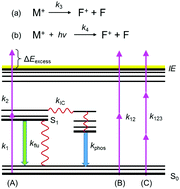Resonant and non-resonant femtosecond ionization mass spectrometry of organochlorine pesticides†
Abstract
Thirteen organochlorine pesticides in a standard sample mixture were measured by gas chromatography combined with mass spectrometry using an ultraviolet femtosecond laser (267 nm) as the ionization source, and the observed mass spectra were compared with the corresponding spectra obtained using an electron ionization source. When an ultrashort optical pulse was used for ionization, molecular ions were typically produced which was preferential for reliably identifying the analytes. The ionization mechanism was studied based on three models constructed for resonance-enhanced two-photon ionization, non-resonant two-photon ionization, and non-resonant three-photon ionization. The optimal conditions for observing a molecular ion were investigated using data obtained for three pulse widths. The results suggest that two-photon ionization with minimum excess energy would be optimal for observing a molecular ion.



 Please wait while we load your content...
Please wait while we load your content...